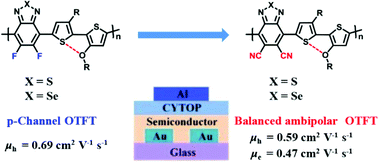Cyano-substituted benzochalcogenadiazole-based polymer semiconductors for balanced ambipolar organic thin-film transistors†
Abstract
Due to their high-lying lowest unoccupied molecular orbitals (LUMOs), π-conjugated polymers based on benzothiadiazole and its derivatives typically are p-type. We report here the successful development of two narrow bandgap, ambipolar donor–acceptor copolymers, PDCNBT2T and PDCNBSe2T, which are based on new cyano-substituted strong electron acceptors, 4,7-dibromo-5,6-dicyano-2,1,3-benzothiadiazole (DCNBT) and 4,7-dibromo-5,6-dicyano-2,1,3-benzoselenadiazole (DCNBSe), respectively. Compared to their polymer analogues with fluorine substituents, the LUMO was lowered by a big margin of ca. 0.6 eV and the bandgap was reduced by 0.2–0.3 eV for the cyano-substituted polymers. Therefore, the cyano-substituted benzothiadiazole polymers showed very low-lying LUMO levels of ca. 4.3 eV. Benefiting from their narrow bandgaps of 1.1–1.2 eV and appropriately positioned LUMO levels, both polymers exhibit well balanced ambipolar transport characteristics in organic thin-film transistors, which differ from the p-type dominating transport properties of their fluorinated polymer analogues. A balanced hole/electron mobility of 0.59/0.47 cm2 V−1 s−1 was achieved for polymer PDCNBT2T, and a reduced hole/electron mobility of 0.018/0.014 cm2 V−1 s−1 was observed for the benzoselenadiazole-based PDCNBSe2T due to its lower crystallinity. These results show that the electron mobility can be enhanced by approximately two orders versus the electron mobility of the previously reported 4,7-di(thiophen-2-yl)-5,6-dicyano-2,1,3-benzothiadiazole-based polymer. This improvement was achieved by using the new acceptor units without additional electron-rich thiophene flanks, which allow a higher degree of freedom in selecting the donor co-unit and more effective tuning of energy levels of frontier molecular orbitals.



 Please wait while we load your content...
Please wait while we load your content...